
For more detailed information about our services and fees, kindly reach out via email at [email protected] or Whatsapp us at +44 7918 249545
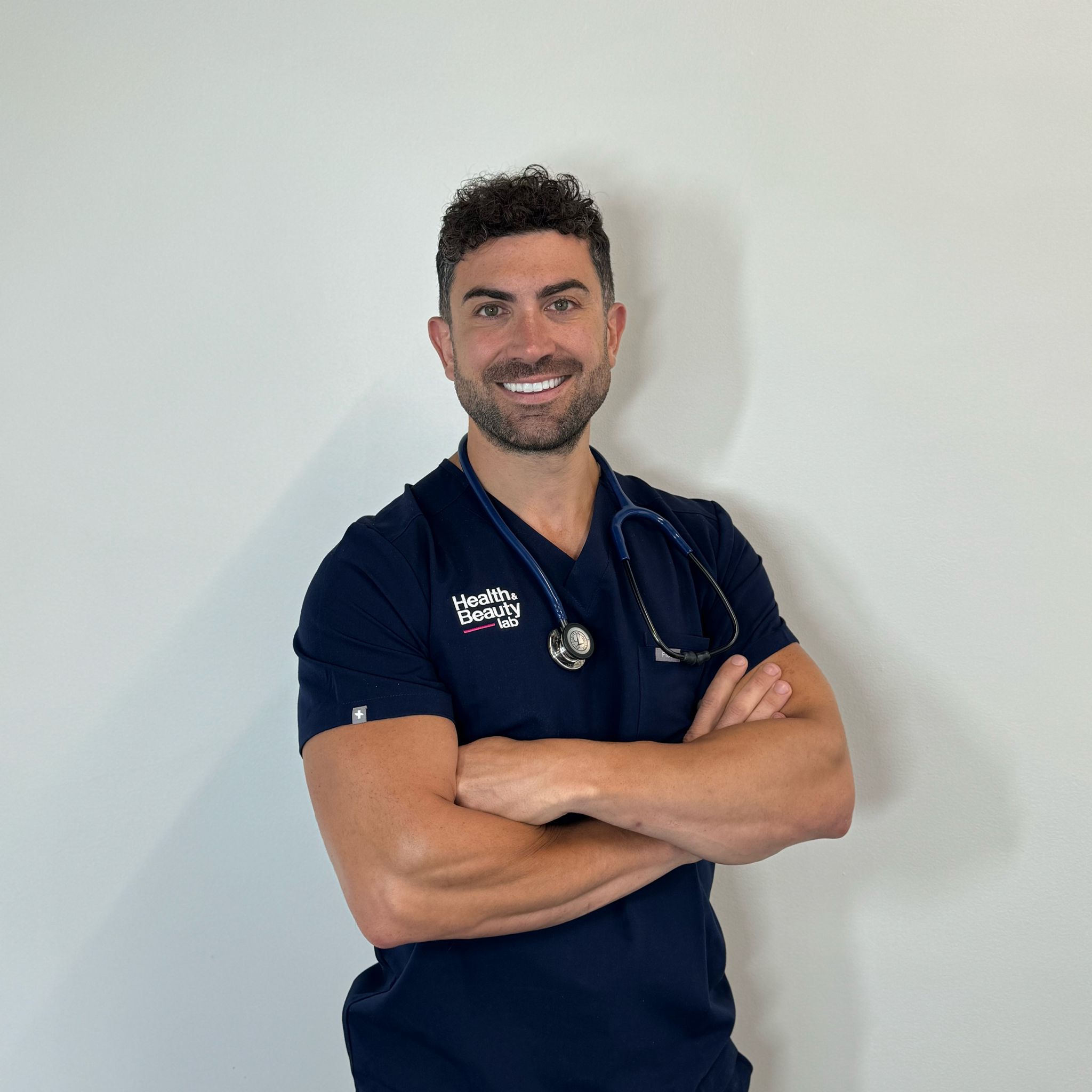

For more detailed information about our services and fees, kindly reach out via email at [email protected] or Whatsapp us at +44 7918 249545

Located in the heart of London on Baker Street, we take a holistic approach to health and beauty, combining Aesthetic Treatments (Anti-Wrinkle Injections, Dermal Fillers) with Osteopathy to enhance both how you feel and how you look.
With several years of experience in aesthetic medicine, We specialize in natural, subtle enhancements that refine your features rather than alter them. Our goal is to enhance your unique beauty—not to change it, helping you look refreshed, youthful, and be more confident.
Beyond aesthetics, Our expertise in osteopathy allows Us to take a comprehensive approach to care. Our treatments go beyond symptom relief to address the root cause of discomfort, helping restore balance and long-term well-being. We use techniques such as joint mobilization, dry needling, myofascial release, soft tissue therapy, and spinal manipulations (HVT – the controlled, precise techniques often known as “clicking” or “adjustments”) to relieve pain and improve mobility. Even relaxation-focused treatments are approached with an expert clinical perspective to maximize their effectiveness.
With over a decade of experience in personal training and sports massage therapy, We have a deep understanding of movement, function, and recovery, which enhances Our work as osteopaths.
Our Services
Why Choose Us?
We continuously refine our skills, staying up to date with the latest advancements to provide the most precise and effective treatments.
Enhance your health, confidence, and natural beauty with expert care. Contact us to book your session today!
A full-body assessment and treatment designed to address musculoskeletal imbalances, relieve pain, and improve mobility. Techniques may include joint mobilization, myofascial release, and soft tissue therapy, depending on your individual needs.
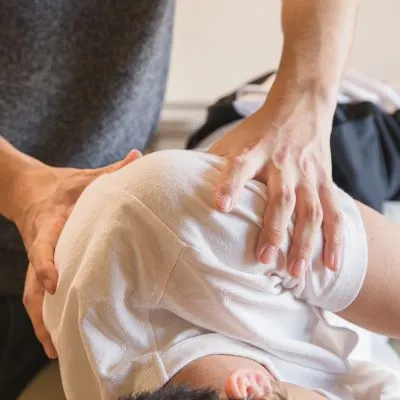
An osteopath is a highly trained healthcare professional who specializes in a holistic approach to diagnosing, treating, and preventing a wide range of musculoskeletal and functional disorders. Osteopaths focus on the body’s interconnected systems, emphasizing the importance of the musculoskeletal system in overall health. They use a combination of manual techniques, patient education, and lifestyle advice to promote wellness and alleviate pain, helping patients achieve optimal physical and emotional well-being. Osteopathy aims to restore balance, mobility, and function, allowing the body to heal itself naturally. Osteopaths treat a diverse patient population, including individuals with back pain, joint issues, sports injuries, and various chronic conditions, tailoring their care to each patient’s unique needs.
Here is a list of common conditions that osteopaths often treat:
It’s important to note that osteopaths take a holistic approach to healthcare, considering not only the specific condition but also the patient’s overall health and well-being. They may use a variety of manual techniques, including manipulation, stretching, and massage, to promote healing and improve function. Osteopathic treatment plans are often tailored to the individual needs and preferences of the patient. If you have a specific condition or concern, it’s advisable to consult with an osteopath to discuss your treatment options.
A targeted treatment that focuses on releasing muscle tension, improving circulation, and reducing pain. Unlike traditional massage, this approach integrates osteopathic techniques to address the root causes of discomfort, making it ideal for athletes, active individuals, and those experiencing chronic tension.
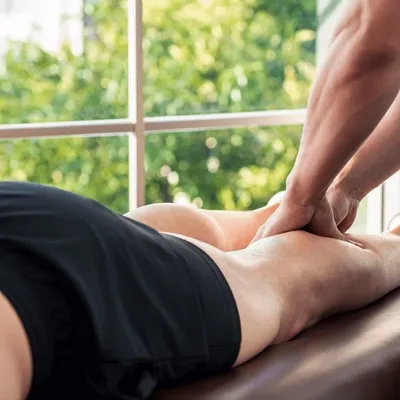
Deep Tissue & Sports Therapy is a specialized hands-on treatment designed to target muscle tension, improve mobility, and aid in recovery. Unlike standard massage, this therapy integrates osteopathic techniques to address musculoskeletal imbalances, ensuring a more effective and results-driven approach.
This treatment focuses on deep pressure and targeted manipulations, helping to release chronic muscle tightness, enhance circulation, and improve tissue elasticity. Whether you are an athlete looking to optimize performance or someone experiencing persistent muscular discomfort, this therapy is designed to provide long-lasting relief.
Benefits of Deep Tissue & Sports Therapy:
References:
Davis HL, Alabed S, Chico TJAEffect of sports massage on performance and recovery: a systematic review and meta-analysisBMJ Open Sport & Exercise Medicine 2020;6:e000614. doi: 10.1136/bmjsem-2019-000614
*Huang, S. Y., Di Santo, M., Wadden, K. P., Cappa, D. F., Alkanani, T., & Behm, D. G. (2010). Short-duration massage at the hamstrings musculotendinous junction induces greater range of motion. Journal of strength and conditioning research, 24(7), 1917–1924. https://doi.org/10.1519/JSC.0b013e3181e06e0c *
Hopper D, Deacon S, Das S, et al. Dynamic soft tissue mobilisation increases hamstring flexibility in healthy male subjects. Br J Sports Med 2005;39:5948.doi:10.1136/bjsm.2004.011981pmid:http://www.ncbi.nlm.nih.gov/pubmed/16118294
Hoffman MD, Badowski N, Chin J, et al. A randomized controlled trial of massage and pneumatic compression for Ultramarathon recovery. J Orthop Sports Phys Ther 2016;46:320–6.doi:10.2519/jospt.2016.6455pmid:http://www.ncbi.nlm.nih.gov/pubmed/27011305
Kargarfard M, Lam ETC, Shariat A, et al. Efficacy of massage on muscle soreness, perceived recovery, physiological restoration and physical performance in male bodybuilders. J Sports Sci 2016;34:1–7.doi:10.1080/02640414.2015.1081264pmid:http://www.ncbi.nlm.nih.gov/pubmed/26334128
Brummitt J. (2008). The role of massage in sports performance and rehabilitation: current evidence and future direction. North American journal of sports physical therapy : NAJSPT, 3(1), 7–21.
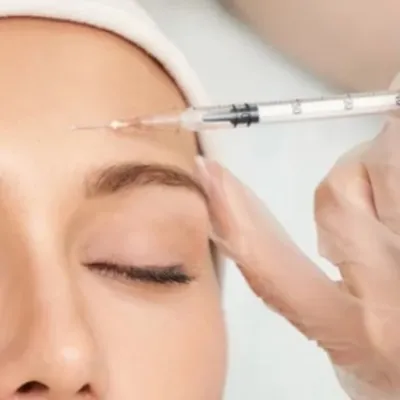
Botulinum toxin is a neurotoxic protein produced by the bacterium Clostridium botulinum. It is the most potent toxin known and in controlled and diluted forms, botulinum toxin is used for medical and cosmetic purposes.
There are several types of botulinum toxin, designated as types A, B, C, D, E, F, and G. The most used for medical and cosmetic applications are types A and B.
Here’s how botulinum toxin works:
In medical applications, botulinum toxin is used to treat various conditions characterized by overactive muscles or unwanted muscle contractions.
Some common medical uses include:
Additionally, the effects are temporary, and repeat injections are often necessary to maintain the desired results.
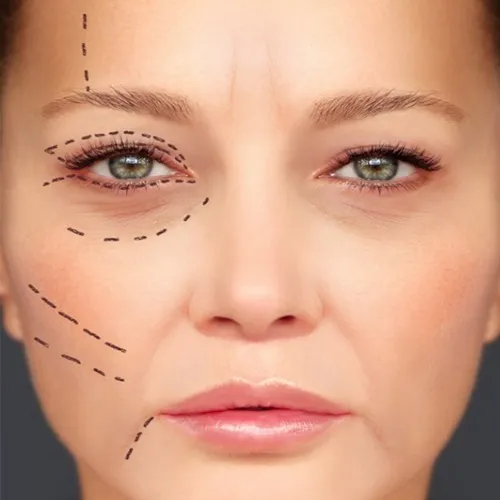
Dermal fillers are cosmetic injectables designed to add volume, contour, and reduce the appearance of wrinkles and fine lines in the face. They are commonly used to restore a more youthful and refreshed appearance. Unlike botulinum toxin, which relaxes muscles to reduce wrinkles, fillers work by adding volume to the treated area.
Here’s how dermal fillers generally work:
Composition:
Dermal fillers are typically made of various substances, and the specific type of filler used can vary. Common filler ingredients include hyaluronic acid, collagen, calcium hydroxylapatite, and poly-L-lactic acid. Hyaluronic acid is one of the most widely used and versatile fillers.
Injection Process:
The filler is injected beneath the skin’s surface, directly into the targeted areas. The injection is performed with a fine needle or a cannula, depending on the technique and the area being treated.
Volume Restoration:
Once injected, the filler adds volume to the treated area, filling in wrinkles, lines, or areas with lost volume. It helps to restore a smoother, plumper appearance to the skin.
Stimulation of Collagen Production:
In addition to providing immediate volume, some fillers stimulate the production of collagen, a protein that supports the structure and elasticity of the skin. This collagen production contributes to longer-term improvements in skin texture and firmness.
Duration of Effects:
The duration of filler effects varies based on the type of filler used. Some fillers provide temporary results, lasting several months to a year, while others offer longer-lasting results.

Botulinum toxin is a neurotoxic protein produced by the bacterium Clostridium botulinum. It is the most potent toxin known and in controlled and diluted forms, botulinum toxin is used for medical and cosmetic purposes.
There are several types of botulinum toxin, designated as types A, B, C, D, E, F, and G. The most used for medical and cosmetic applications are types A and B.
Here’s how botulinum toxin works:
In medical applications, botulinum toxin is used to treat various conditions characterized by overactive muscles or unwanted muscle contractions.
Some common medical uses include:
Additionally, the effects are temporary, and repeat injections are often necessary to maintain the desired results.

Botulinum toxin is a neurotoxic protein produced by the bacterium Clostridium botulinum. It is the most potent toxin known and in controlled and diluted forms, botulinum toxin is used for medical and cosmetic purposes.
There are several types of botulinum toxin, designated as types A, B, C, D, E, F, and G. The most used for medical and cosmetic applications are types A and B.
Here’s how botulinum toxin works:
In medical applications, botulinum toxin is used to treat various conditions characterized by overactive muscles or unwanted muscle contractions.
Some common medical uses include:
Additionally, the effects are temporary, and repeat injections are often necessary to maintain the desired results.

Dermal fillers are cosmetic injectables designed to add volume, contour, and reduce the appearance of wrinkles and fine lines in the face. They are commonly used to restore a more youthful and refreshed appearance. Unlike botulinum toxin, which relaxes muscles to reduce wrinkles, fillers work by adding volume to the treated area.
Here’s how dermal fillers generally work:
Composition:
Dermal fillers are typically made of various substances, and the specific type of filler used can vary. Common filler ingredients include hyaluronic acid, collagen, calcium hydroxylapatite, and poly-L-lactic acid. Hyaluronic acid is one of the most widely used and versatile fillers.
Injection Process:
The filler is injected beneath the skin’s surface, directly into the targeted areas. The injection is performed with a fine needle or a cannula, depending on the technique and the area being treated.
Volume Restoration:
Once injected, the filler adds volume to the treated area, filling in wrinkles, lines, or areas with lost volume. It helps to restore a smoother, plumper appearance to the skin.
Stimulation of Collagen Production:
In addition to providing immediate volume, some fillers stimulate the production of collagen, a protein that supports the structure and elasticity of the skin. This collagen production contributes to longer-term improvements in skin texture and firmness.
Duration of Effects:
The duration of filler effects varies based on the type of filler used. Some fillers provide temporary results, lasting several months to a year, while others offer longer-lasting results.

Treatment Areas:
Skin boosters are a type of aesthetic treatment designed to improve the hydration, texture, and overall quality of the skin. These treatments involve the injection of specialized substances, typically hyaluronic acid, into the skin to enhance moisture levels and stimulate collagen production. Skin boosters are also known as hydrating injections or injectable moisturizers.
Here’s how skin boosters generally work:
Common Uses:
Number of Sessions:
Skin boosters are typically well-tolerated, and the downtime is minimal.
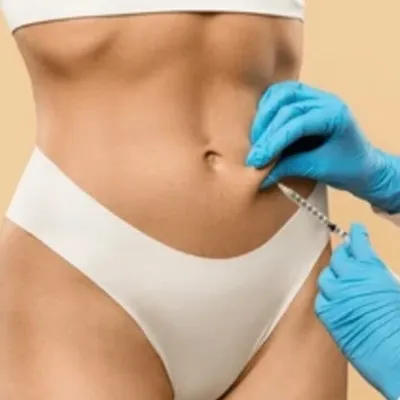
Fat dissolving, also known as non-surgical fat reduction or injection lipolysis, is a cosmetic procedure designed to reduce localized pockets of fat without surgery. One common method involves the use of injectable compounds, such as deoxycholic acid, to break down and eliminate fat cells. This procedure is often used for contouring areas with excess fat, such as under the chin (submental fat).
Here’s how fat dissolving works:
It’s crucial to have a consultation with a healthcare professional to determine if fat dissolving is a suitable option for your specific goals and to discuss potential risks and benefits.
Health Services

A holistic approach to pain relief and mobility, restoring balance through osteopathic techniques..

Targeted deep pressure therapy to relieve muscle tension, enhance recovery, and improve mobility.
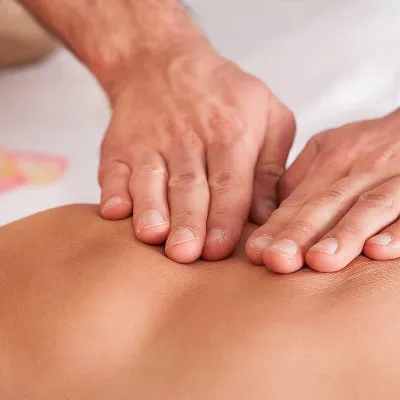
Precision techniques to release fascial restrictions and relieve deep-seated muscular tension.
A full-body assessment and treatment designed to address musculoskeletal imbalances, relieve pain, and improve mobility. Techniques may include joint mobilization, myofascial release, and soft tissue therapy, depending on your individual needs.

An osteopath is a highly trained healthcare professional who specializes in a holistic approach to diagnosing, treating, and preventing a wide range of musculoskeletal and functional disorders. Osteopaths focus on the body’s interconnected systems, emphasizing the importance of the musculoskeletal system in overall health. They use a combination of manual techniques, patient education, and lifestyle advice to promote wellness and alleviate pain, helping patients achieve optimal physical and emotional well-being. Osteopathy aims to restore balance, mobility, and function, allowing the body to heal itself naturally. Osteopaths treat a diverse patient population, including individuals with back pain, joint issues, sports injuries, and various chronic conditions, tailoring their care to each patient’s unique needs.
Here is a list of common conditions that osteopaths often treat:
It’s important to note that osteopaths take a holistic approach to healthcare, considering not only the specific condition but also the patient’s overall health and well-being. They may use a variety of manual techniques, including manipulation, stretching, and massage, to promote healing and improve function. Osteopathic treatment plans are often tailored to the individual needs and preferences of the patient. If you have a specific condition or concern, it’s advisable to consult with an osteopath to discuss your treatment options.
A targeted treatment that focuses on releasing muscle tension, improving circulation, and reducing pain. Unlike traditional massage, this approach integrates osteopathic techniques to address the root causes of discomfort, making it ideal for athletes, active individuals, and those experiencing chronic tension.

Deep Tissue & Sports Therapy is a specialized hands-on treatment designed to target muscle tension, improve mobility, and aid in recovery. Unlike standard massage, this therapy integrates osteopathic techniques to address musculoskeletal imbalances, ensuring a more effective and results-driven approach.
This treatment focuses on deep pressure and targeted manipulations, helping to release chronic muscle tightness, enhance circulation, and improve tissue elasticity. Whether you are an athlete looking to optimize performance or someone experiencing persistent muscular discomfort, this therapy is designed to provide long-lasting relief.
Benefits of Deep Tissue & Sports Therapy:
References:
Davis HL, Alabed S, Chico TJAEffect of sports massage on performance and recovery: a systematic review and meta-analysisBMJ Open Sport & Exercise Medicine 2020;6:e000614. doi: 10.1136/bmjsem-2019-000614
*Huang, S. Y., Di Santo, M., Wadden, K. P., Cappa, D. F., Alkanani, T., & Behm, D. G. (2010). Short-duration massage at the hamstrings musculotendinous junction induces greater range of motion. Journal of strength and conditioning research, 24(7), 1917–1924. https://doi.org/10.1519/JSC.0b013e3181e06e0c *
Hopper D, Deacon S, Das S, et al. Dynamic soft tissue mobilisation increases hamstring flexibility in healthy male subjects. Br J Sports Med 2005;39:5948.doi:10.1136/bjsm.2004.011981pmid:http://www.ncbi.nlm.nih.gov/pubmed/16118294
Hoffman MD, Badowski N, Chin J, et al. A randomized controlled trial of massage and pneumatic compression for Ultramarathon recovery. J Orthop Sports Phys Ther 2016;46:320–6.doi:10.2519/jospt.2016.6455pmid:http://www.ncbi.nlm.nih.gov/pubmed/27011305
Kargarfard M, Lam ETC, Shariat A, et al. Efficacy of massage on muscle soreness, perceived recovery, physiological restoration and physical performance in male bodybuilders. J Sports Sci 2016;34:1–7.doi:10.1080/02640414.2015.1081264pmid:http://www.ncbi.nlm.nih.gov/pubmed/26334128
Brummitt J. (2008). The role of massage in sports performance and rehabilitation: current evidence and future direction. North American journal of sports physical therapy : NAJSPT, 3(1), 7–21.
A specialized technique designed to release tight fascia and muscle knots, restoring movement and reducing pain. This treatment is particularly effective for conditions like fibromyalgia, chronic pain, and tension-related discomfort.

Myofascial Release & Trigger Point Therapy is a specialized osteopathic-based treatment designed to release fascial restrictions, alleviate muscle knots (trigger points), and restore mobility. Unlike traditional deep tissue massage, this approach targets connective tissue (fascia) and neuromuscular trigger points, addressing the root cause of pain and tension rather than just the symptoms.
Using sustained pressure and precise techniques, this therapy helps break down adhesions, improve circulation, and promote better movement. It is particularly effective for individuals experiencing chronic pain, postural imbalances, or conditions like fibromyalgia, tension headaches, and nerve impingement.
Benefits of Myofascial Release & Trigger Point Therapy:
References:
A gentle, rhythmic technique that stimulates the lymphatic system to promote detoxification, reduce swelling, and support immune function. This approach is particularly beneficial for post-surgery recovery, inflammation, and fluid retention.
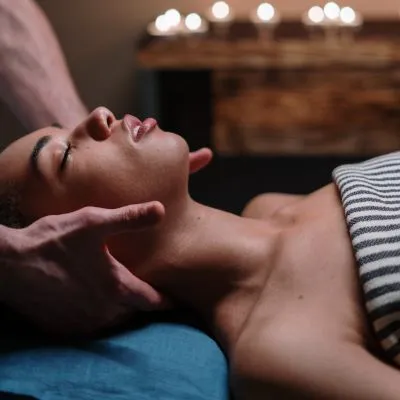
Lymphatic drainage is a light massage on the skin that helps promote the movement of lymphatic fluid. In contrast to other massage approaches, lymphatic drainage focuses specifically on lymph vessels to assist the flow of the lymph.
Mechanisms of action
References:
Tzani I, Tsichlaki M, Zerva E, Papathanasiou G, Dimakakos E. Physiotherapeutic rehabilitation of lymphedema: State-of-the-art. Lymphology. 2018 Jul 2;51(1):1-2.
Crisóstomo RS, Candeias MS, Armada-da-Silva PA. Venous flow during manual lymphatic drainage applied to different regions of the lower extremity in people with and without chronic venous insufficiency: a cross-sectional study.Physiotherapy. 2016 Feb 1. pii: S0031-9406(16)00023-7.
Lymphoedema Framework. Best Practice for the Management of Lymphoedema. International consensus. London: MEP Ltd, 2006.
Ebert, J. R., Joss, B., Jardine, B., & Wood, D. J. (2013). Randomized trial investigating the efficacy of manual lymphatic drainage to improve early outcome after total knee arthroplasty. Archives of physical medicine and rehabilitation, 94(11), 2103–2111. https://doi.org/10.1016/j.apmr.2013.06.009
Happe, S., Peikert, A., Siegert, R., & Evers, S. (2016). The efficacy of lymphatic drainage and traditional massage in the prophylaxis of migraine: a randomized, controlled parallel group study. Neurological sciences : official journal of the Italian Neurological Society and of the Italian Society of Clinical Neurophysiology, 37(10), 1627–1632. https://doi.org/10.1007/s10072-016-2645-3
Masson, I. F., de Oliveira, B. D., Machado, A. F., Farcic, T. S., Júnior, I. E., & Baldan, C. S. (2014). Manual lymphatic drainage and therapeutic ultrasound in liposuction and lipoabdominoplasty post-operative period. Indian journal of plastic surgery : official publication of the Association of Plastic Surgeons of India, 47(1), 70–76. https://doi.org/10.4103/0970-0358.129627
Effects of manual lymph drainage for abdomen on the brain activity of subjects with psychological stress. Journal of physical therapy science. 2017;29(3):491-4.
Not sure which treatment is best for you? Book a consultation, and I will create a customized session based on your needs—whether it’s pain relief, mobility improvement, or deep relaxation with a clinical approach.
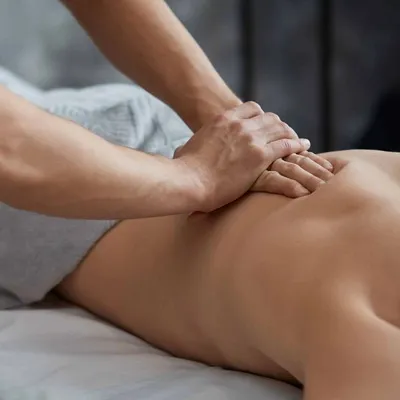
Every body is unique, and so is every treatment. Using an osteopathic approach, I customize each session to address your specific needs—whether it’s pain relief, improved mobility, or relaxation. Relaxation can be achieved through various techniques, including gentle soft tissue therapy, diaphragmatic release, and guided breathing techniques, ensuring a fully personalized and effective experience for your well-being.
Combination of treatment modalities to manage or reduce the pain and discomfort.
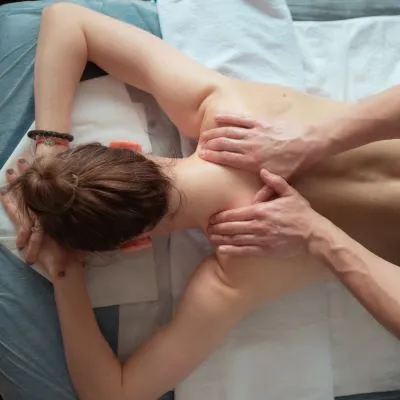
In pain management, we use a combination of treatment modalities tailored to your presentation to manage or reduce the pain and discomfort. The difference of pain management compared to other services is that within a treatment session the practitioner will assess you and depending on the findings, will select and use a combination of treatment modalities that are most appropriate for you.
Some examples of the treatment modalities can include:
Combines joint mobilisation techniques with stretching.
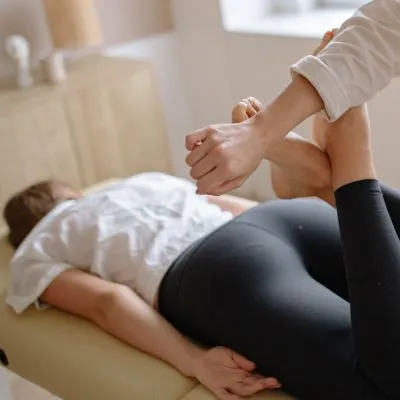
Stretching and mobility are two of the most common and effective interventions to manage musculoskeletal pain. In this treatment, the trained practitioner combines joint mobilisation techniques with stretching. Some of the techniques in this session are passive (done by the practitioner) and others are more dynamic (exercise-based). This combination can optimize the recovery process.
Effects of stretching:
Effects of joint mobilisation:
References:
Procedure where a small needle is inserted into the muscle, aiming to treat trigger points. Trigger points are muscular nodules that are palpable and tender. These nodules can cause pain on the surrounding area and to distant areas of the body, a phenomenon called "referred pain"
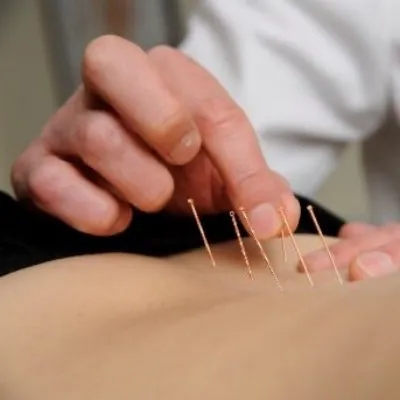
Dry needling is a procedure where a small needle is inserted into the muscle, aiming to treat trigger points. Trigger points are muscular nodules that are palpable and tender. These nodules can cause pain on the surrounding area and to distant areas of the body, a phenomenon called ''referred pain''.[1]
Evidence-based effects of dry needling therapy
Is it a painful procedure?
Even if the insertion of a needle in the muscle might seem painful, the
needles are very thin and don't cause pain. There are times when the
insertion of the needle might cause a muscle twitch, but this is not
commonly described as painful by the patients.
Am I going to be sore?
As with most musculskeletal treatments, there might be some mild muscle
soreness for 24-48 hours following a treatment.
References:
Shah, J. P., Thaker, N., Heimur, J., Aredo, J. V., Sikdar, S., & Gerber, L. (2015). Myofascial Trigger Points Then and Now: A Historical and Scientific Perspective. PM & R : the journal of injury, function, and rehabilitation, 7(7), 746–761. https://doi.org/10.1016/j.pmrj.2015.01.024
Itoh, K., Katsumi, Y., Hirota, S., & Kitakoji, H. (2007). Randomised trial of trigger point acupuncture compared with other acupuncture for treatment of chronic neck pain. Complementary therapies in medicine, 15(3), 172–179. https://doi.org/10.1016/j.ctim.2006.05.003
Dunning, J., Butts, R., Mourad, F., Young, I., Flannagan, S., & Perreault, T. (2014). Dry needling: a literature review with implications for clinical practice guidelines. Physical therapy reviews : PTR, 19(4), 252–265. https://doi.org/10.1179/108331913X13844245102034
Fishman LM, Dombi GW, Michaelsen C, Ringel S, Rozbruch J, Rosner B, et al. Piriformis syndrome: diagnosis, treatment, and outcome–a 10-year study. Arch Phys Med Rehabil. 2002;83(3):295–301
Khosrawi S, Moghtaderi A, Haghighat S. Acupuncture in treatment of carpal tunnel syndrome: a randomized controlled trial study. J Res Med Sci. 2012;17(1):1–7
Allais G, De Lorenzo C, Quirico PE, Airola G, Tolardo G, Mana O, et al. Acupuncture in the prophylactic treatment of migraine without aura: a comparison with flunarizine. Headache. 2002;42(9):855–61
Osborne NJ, Gatt IT. Management of shoulder injuries using dry needling in elite volleyball players. Acupunct Med. 2010;28(1):42–5
Tough EA, White A. Effectiveness of acupuncture/dry needling for myofascial trigger point pain–a systematic review. Phys Ther Rev. 2011;16(2):147–54
Vas J, Aranda JM, Modesto M, Benítez-Parejo N, Herrera A, Martínez-Barquín DM, et al. Acupuncture in patients with acute low back pain: a multicentre randomised controlled clinical trial. Pain. 2012;153(9):1883–9
Zhang S, Yip T, Li Q. Acupuncture treatment for plantar fasciitis: a randomized controlled trial with six months follow-up. Evid Based Complement Alternat Med. 2009;20(11):1–10.
Scraping therapy utilizes instruments with smooth edges to scrape the skin until red blemishes occur. The aim of this intervention is to break down fascial restrictions and scar tissue that could have developed as a result of immobilization, surgery, or musculoskeletal strains and injuries.
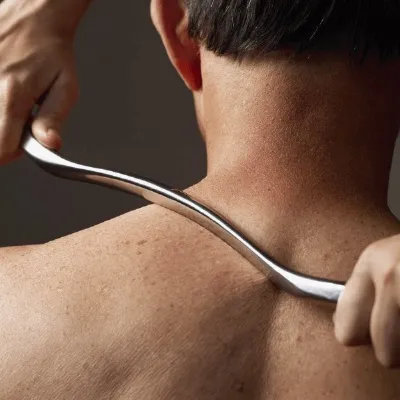
Effects of scraping therapy based on research:
References
Cheatham SW, Baker R, Kreiswirth E. Instrument assisted soft-tissue mobilization: A commentary on clinical practice guidelines for rehabilitation professionals. International journal of sports physical therapy. 2019 Jul;14(4):670.
Xu, Q. Y., Yang, J. S., Zhu, B., Yang, L., Wang, Y. Y., & Gao, X. Y. (2012). The effects of scraping therapy on local temperature and blood perfusion volume in healthy subjects. Evidence-based complementary and alternative medicine : eCAM, 2012, 490292. https://doi.org/10.1155/2012/490292
McConnell J, Cruser S, Warden SJ, Bayliss AJ. Instrument-assisted soft tissue mobilization alters material and mechanical properties in Achilles tendinopathy. J Orthop Sports Phys Ther. 2016;46:114
Lee JH, Lee DK, Oh JS. The effect of Graston technique on the pain and range of motion in patients with chronic low back pain. J Phys Ther Sci. 2016;28:1852–1855.
Baker RT, Nasypany A, Seegmiller JG, Baker JG. Instrument-assisted soft tissue mobilization treatment for tissue extensibility dysfunction. Int J Athl The Train. 2013;18:16–21
Percussive massage therapy or vibration therapy uses specific tools (massage guns) that create a very short and fast vibratory movement on the applied muscle. Depending on the tissue applied in, the practitioner uses different massage gun heads and frequencies of vibration to tailor the treatment.
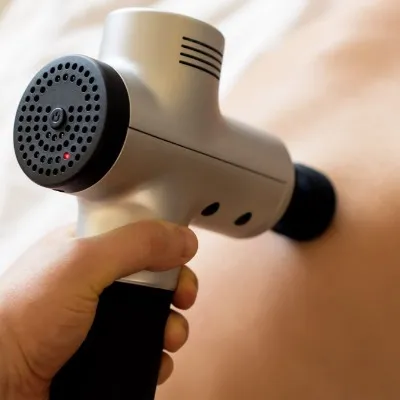
Percussive massage therapy or vibration therapy use specific tools (massage guns) that create a very short and fast vibratory movement on the applied muscle. Depending on the tissue applied in, the practitioner uses different massage gun heads and frequencies of vibration to tailor the treatment.[1]
Effectiveness of massage therapy according to research
References:
Konrad, A., Glashüttner, C., Reiner, M. M., Bernsteiner, D., & Tilp, M. (2020). The Acute Effects of a Percussive Massage Treatment with a Hypervolt Device on Plantar Flexor Muscles' Range of Motion and Performance. Journal of sports science & medicine, 19(4), 690–694.
Germann D., El Bouse A., Shnier J., Abdelkader N., Kazemi M. (2018) Effects of local vibration therapy on various performance parameters: A narrative literature review. Journal of the Canadian Chiropractic Association 62(3), 170–181
Eriksson Crommert M., Lacourpaille L., Heales L. J., Tucker K., Hug F. (2015). Massage induces an immediate, albeit short-term, reduction in muscle stiffness. Scandinavian Journal of Medicine and Science in Sports 25(5), e490–e496
Cheatham S. W., Stull K. R., Kolber M. J. (2019) Comparison of a vibration roller and a nonvibration roller intervention on knee range of motion and pressure pain threshold: A randomized controlled trial. Journal of Sport Rehabilitation 28(1), 39–45.
Veqar, Z., & Imtiyaz, S. (2014). Vibration Therapy in Management of Delayed Onset Muscle Soreness (DOMS). Journal of clinical and diagnostic research : JCDR, 8(6), LE01–LE4. https://doi.org/10.7860/JCDR/2014/7323.4434
Cupping is a physical treatment which utilizes a glass or a bamboo cup to create suction in the skin over a painful area [1]. It is an ancient technique that was even used by the Greek physician Hippocrates, commonly referred as the ‘’father’’ of medicine. Its aim is to release toxins from body tissue and organs and to increase blood flow to the area applied to.
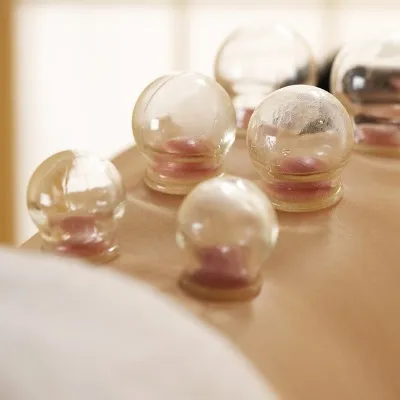
Cupping is a physical treatment which utilizes a glass or a bamboo cup to create suction in the skin over a painful area [1]. It is an ancient technique that was even used by the Greek physician Hippocrates, commonly referred as the ‘’father’’ of medicine. Its aim is to release toxins from body tissue and organs and to increase blood flow to the area applied to.
Effects of cupping therapy according to research:
References:
Kim, J. I., Lee, M. S., Lee, D. H., Boddy, K., & Ernst, E. (2011). Cupping for treating pain: a systematic review. Evidence-based complementary and alternative medicine : eCAM, 2011, 467014. https://doi.org/10.1093/ecam/nep035
Yuan Q-l, Guo T-m, Liu L., Sun F., Zhang Y-g. Traditional Chinese medicine for neck pain and low back pain: a systematic review and meta analysis. PLoS One. 2015;10:2.
AlBedah A. The use of wet cupping for persistent nonspecific low back pain: randomized controlled clinical trial. J Alternative Compl Med. 2015;21:504–508. 8.
Cao H., Hu H., Colagiuri B., Liu J. Medicinal cupping therapy in 30 patients with fibromyalgia: a case series observation. Forsch Komplementmed. 2011;18:122–126
Michalsen A., Bock S., Lüdtke R., Rampp T. Effects of traditional cupping therapy in patients with carpal tunnel syndrome: a randomized controlled trial. J Pain. 2009;10:601–608
Ahmadi A., Schwebel D.C., Rezaei M. The Efficacy of wet-cupping in the treatment of tension and migraine headache. Am J Chin Med. 2008;36:37–44. 1.
Ahmed A., Khan R.A., Ali A.A., Ahmed M., Mesaik M.A. Effect of wet cupping therapy on virulent cellulitis secondary to honey bee sting–a case report. J Basic Appl Sci. 2011;7:123–125.
Contact Us